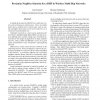Free Online Productivity Tools
i2Speak
i2Symbol
i2OCR
iTex2Img
iWeb2Print
iWeb2Shot
i2Type
iPdf2Split
iPdf2Merge
i2Bopomofo
i2Arabic
i2Style
i2Image
i2PDF
iLatex2Rtf
Sci2ools
P2P
2005
IEEE
2005
IEEE
Proximity Neighbor Selection for a DHT in Wireless Multi-Hop Networks
A mobile ad hoc network (MANET) is a multi-hop wireless network having no infrastructure. Thus, the mobile nodes have to perform basic control tasks, such as routing, and higher-level tasks, such as service discovery, in a cooperative and distributed way. Originally conceived as a peer-to-peer application for the Internet, distributed hash tables (DHTs) are data structures offering both, scalable routing and a convenient abstraction for the design of applications in large, dynamic networks. Hence, DHTs and MANETs seem to be a good match, and both have to cope with dynamic, self-organizing networks. DHTs form a virtual control structure oblivious to the underlying network. Several techniques to improve the performance of DHTs in wired networks have been established in the literature. A particularly efficient one is proximity neighbor selection (PNS). PNS has to continuously adapt the virtual network to the physical network, incurring control traffic. The applicability of PNS and DHTs...
Control Traffic | Mobile Ad Hoc Network | Multi-hop Wireless Network | P2P 2005 | Peer-to-Peer Computing |
| Added | 25 Jun 2010 |
| Updated | 25 Jun 2010 |
| Type | Conference |
| Year | 2005 |
| Where | P2P |
| Authors | Curt Cramer, Thomas Fuhrmann |
Comments (0)

